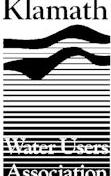
Klamath Water Users Association
KWUA's response to today's Seattle P-I editorial on the Blumenauer amendment.
|
|
Klamath Water Users Association KWUA's response to today's Seattle P-I editorial on the Blumenauer amendment.
|
|
Wednesday, July 16, 2003
Klamath crisis calls for common sense
Congressional representatives have a chance to take a
small step toward water and salmon sanity in the Klamath Basin around
the Oregon-California border. They should grab at a rare opportunity to
impose common sense.
A bipartisan proposal would require that two basin wildlife refuges be treated like others, as places dedicated to protecting America's natural resources. The measure, which is expected to receive a House vote this week, would phase out inappropriate commercial farming on the Lower Klamath and Tule Lake refuges. Those are the only refuges where leaseholders can grow purely commercial crops, which include onions, potatoes and horseradish. Farming on other national wildlife refuges provides food for wildlife. There could hardly be worse places for water-intensive crops. Basin water supplies are frequently short. Two reports, by California and the Yurok Tribe biologists, concluded that low water flows contributed to last year's massive Klamath River fish kill. The commercial crops take large amounts of water that could be used by other basin farmers. The leases add heavy pesticide applications to the refuges, which are parts of the Pacific Flyway for waterfowl. This year, Rep. Christopher Shays, R-Conn., has joined Democratic Reps. Earl Blumenauer of Oregon and Mike Thompson of California in sponsoring the phase-out plan, which almost passed a year ago. Common sense should rule. KWUA Response to Seattle P-I Editorial
July 16, 2003
Seattle Post-Intelligencer Letters
to the Editor
Box 1909 Seattle, WA 98111-1909
Dear Editor:
Your recent editorial ("Klamath
crisis calls for common sense", July 16, 2003) regarding Congressman Earl
Blumenauer's proposal to eliminate certain types of crops on the lease
lands of two Klamath Basin wildlife refuges makes about as much sense as
an urban Portland lawmaker making rules that affect rural family farmers
300 miles away.
That's likely
because, in both cases, the premises behind the arguments are simply
incorrect.
The P-I
editorial states that “those refuges (Lower Klamath and Tule Lake) are the
only refuges where leaseholders can grow purely commercial crops.” In
fact, there are eleven states where commercial activities - including
farming - take place on national wildlife refuges. Oranges are grown on a
refuge in Florida, and corn and rice are produced from Arkansas refuges.
In your state of Washington, alfalfa and corn are raised in the
Mid-Columbia National Wildlife Refuge, and Hanford Reach National Wildlife
Refuge is home to a nuclear waste site.
Rep. Blumenauer and the P-I
editorial claim that the leases add heavy pesticide applications to the
refuges. Actually, the refuges and the farmers operate under an integrated
pest management program to minimize to the greatest extent possible the
use of pesticides. It's also important to point out that only 2.2 percent
of the 2,928 different pesticides that are legally used in California -
the state with one of the nation's most restrictive pesticide use laws -
are applied in the Klamath refuges.
Contrary to the P-I's opinion,
restricting potatoes and onions on the lease lands will have a very minor
effect on the quantity of water used on those acres. Grain consumptively
uses about 1.87 acre-ft per acre (AF/ac), while onions use 1.88 AF/ac and
potatoes use 1.73 AF/ac. The same amount of water - or more - is needed to
grow grain, when compared to water needs of onions and potatoes. The
notion that you would save water in any meaningful way for the basin's
other demands is ludicrous.
Finally, to suggest the lease lands
are somehow linked with the Klamath River fish die-off in 2002 is pure
myth-making. It is by no means clear that low flows killed the salmon last
fall. Simply look at 1988, when identical flow conditions existed in the
Lower Klamath River (2,130 cubic feet per second (cfs) in 1988; 2,129 cfs
in 2002). That year, a run of 215,322 salmon occurred on the Klamath River
and no fish die-off occurred. In 2002, 132,600 salmon returned, and 33,000
died on the lower river. In other words, there was a much larger salmon
run in 1988 with the same lower river flow but no fish die-off. Yet the
Yurok Tribes and the State of California - within days of the fish die-off
- assigned the blame for this unfortunate event to the Klamath Project,
located 200 miles upstream. The P-I's editorial perpetuates this
questionable accusation.
There has been much more
accomplished for the refuge water supplies through collaborative efforts
of the growers. Sticking them with a penalty that is harsh to the growers
and local community - but otherwise, purely symbolic - makes no sense
whatsoever.
Sincerely,
Dan Keppen
Executive Director
Klamath Water Users Association
Klamath Falls, Oregon
|
|
Klamath Water Users
Association |
Content and Logo: Copyright © Klamath
Water Users Association, 2002 All Rights
Reserved
Page design: Copyright ©
klamathbasincrisis.org, 2002, All Rights
Reserved